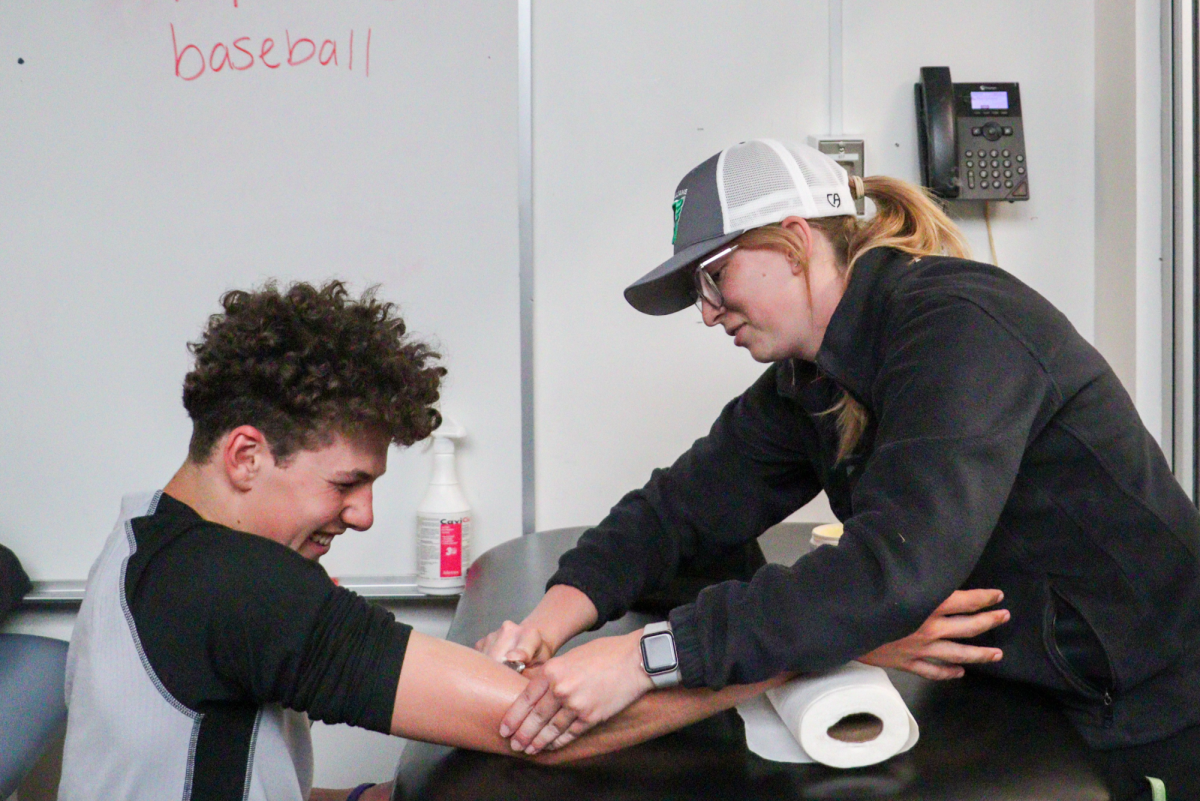“They won’t know the answer to a question, but they still act like they do,” junior Melissa Qin said.
In STEM classes such as AP Physics C, Qin notes that male students are reluctant to admit that they are wrong. Additionally, some of her male classmates tend to mansplain, which is defined as when a man explains a topic, usually to a woman, in a condescending way and under the assumption that they are unfamiliar with it. Many times mansplaining can take the form of interrupting a woman and telling her she’s wrong or even completely taking over a task at hand. This is performed under the impression that the woman doesn’t know what she’s doing, or that she wouldn’t execute it to a man’s level of ability.
In contrast, when Qin tries to explain how to get the correct answer when her peers get a question wrong, she says they don’t listen — instead, they continue to claim they are right, when in reality, they aren’t.
“It made me feel very invisible because as a classmate, why aren’t you listening to me?” Qin said. “I’m telling you why you’re getting the wrong answer and you’re not listening. And you’re still doing it wrong, which is going to hurt you in the future.”
Qin explains that mansplaining is a prevalent issue that can push women out of male-dominated spaces, especially STEM fields. There are also detrimental internal repercussions when she faces this behavior, such as a diminished sense of confidence in the courses where she has to deal with others’ mansplaining.
Additionally, junior Hursh Shah adds that such actions perpetuate, whether subconsciously or intentionally, the regressive notion that women are intellectually inferior to men. Similar to Qin, he correlates mansplaining to seeing more men in fields such as computer science and finance as it forms preconceived notions about women’s abilities. Shah believes that it can also lead men to only surround themselves with others who share the same views.
It made me feel very invisible because as a classmate, why aren’t you listening to me?
— Junior Melissa Qin
On the other hand, unlike in STEM classes, English teacher Derek Lu notices that his female students tend to participate more in his class, and he believes that if there were any incidents of mansplaining, the female students would stop it. Within his class, Lu likes to raise conversations surrounding gender, both connected to the pieces of literature the class discusses and related to each student’s personal experiences. In one activity that he conducted, students had to write a journal entry about gender biases that they have faced.
“I was reading some of my female students’ responses, and they talked about being marginalized in their sport even though they were a team captain,” Lu said. “Another student talked about how she did a summer program for AI research and male interns were given a lot more attention. I can definitely see that kind of gender dynamic and gap in other classes.”
Mansplaining, according to Shah, usually stems from a deep interest in a topic while assuming the other person has a lack of knowledge about it. Despite never having been called out, he admits that there are times when he unintentionally mansplained fields such as finance, which he is interested in, by oversimplifying the topic.
To address mansplaining in his classroom, Lu feels that the environment he has cultivated in his classroom allows for all voices to flourish and also delve into the intricacies of gender dynamics and other gender-related topics.
“As a queer Asian American educator, I always want to strive to create that space of inclusivity for marginalized voices,” Lu said. “A lot of it has to do with how I was brought up and how I went through my schooling experience. Back then, the environment was just so much more stifling. There wasn’t any sort of acknowledgment of safe spaces for queer kids at all and so that really informs my practice as an educator. I always want to uplift more marginalized voices.”
By being more mindful when speaking to others and treating conversations more like discussions instead in non-casual scenarios, Shah strives to maintain an equal power dynamic and reduce the risk of making the other person feel demeaned. Qin also believes that men can practice awareness in what they say to prevent mansplaining. She says that denying its existence is, in itself, a form of mansplaining in which the individual fails to consider others’ perspectives.
“People should talk about mansplaining more,” Qin said. “They should keep it in mind as they interact with women and have a more open mind to what the people around them are saying. I think it’s very important to actually acknowledge this problem because yeah, a woman can mansplain as well [and be] condescending, but it’s the fact that men do it more, and it’s more of a gendered thing when men do it. I think that’s what we should pay attention to.”
This story was originally published on El Estoque on April 12, 2024.
































![IN THE SPOTLIGHT: Junior Zalie Mann performs “I Love to Cry at Weddings,” an ensemble piece from the fall musical Sweet Charity, to prospective students during the Fine Arts Showcase on Wednesday, Nov. 8. The showcase is a compilation of performances and demonstrations from each fine arts strand offered at McCallum. This show is put on so that prospective students can see if they are interested in joining an academy or major.
Sweet Charity originally ran the weekends of Sept. 28 and Oct. 8, but made a comeback for the Fine Arts Showcase.
“[Being at the front in the spotlight] is my favorite part of the whole dance, so I was super happy to be on stage performing and smiling at the audience,” Mann said.
Mann performed in both the musical theatre performance and dance excerpt “Ethereal,” a contemporary piece choreographed by the new dance director Terrance Carson, in the showcase. With also being a dance ambassador, Mann got to talk about what MAC dance is, her experience and answer any questions the aspiring arts majors and their parents may have.
Caption by Maya Tackett.](https://bestofsno.com/wp-content/uploads/2024/02/53321803427_47cd17fe70_o-1-1200x800.jpg)
![SPREADING THE JOY: Sophomore Chim Becker poses with sophomores Cozbi Sims and Lou Davidson while manning a table at the Hispanic Heritage treat day during lunch of Sept 28. Becker is a part of the students of color alliance, who put together the activity to raise money for their club.
“It [the stand] was really fun because McCallum has a lot of latino kids,” Becker said. “And I think it was nice that I could share the stuff that I usually just have at home with people who have never tried it before.”
Becker recognizes the importance of celebrating Hispanic heritage at Mac.
“I think its important to celebrate,” Becker said. “Because our culture is awesome and super cool, and everybody should be able to learn about other cultures of the world.”
Caption by JoJo Barnard.](https://bestofsno.com/wp-content/uploads/2024/01/53221601352_4127a81c41_o-1200x675.jpg)



